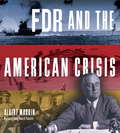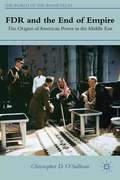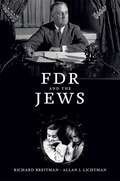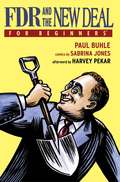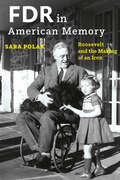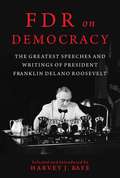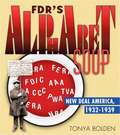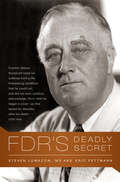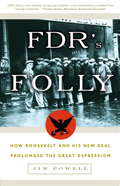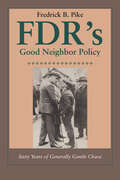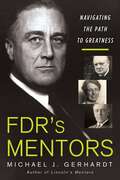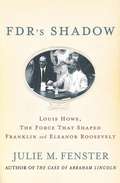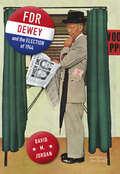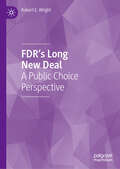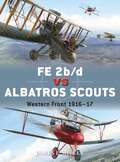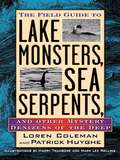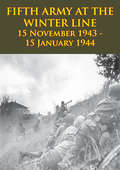- Table View
- List View
FDR and Lucy: Lovers and Friends
by Resa WillisFirst Published in 2005. Routledge is an imprint of Taylor & Francis, an informa company.
FDR and the American Crisis
by Albert MarrinThe definitive biography of president Franklin Delano Roosevelt for young adult readers, from National Book Award finalist Albert Marrin, is a must-have for anyone searching for President's Day reading. Brought up in a privileged family, Franklin Delano Roosevelt had every opportunity in front of him. As a young man, he found a path in politics and quickly began to move into the public eye. That ascent seemed impossible when he contracted polio and lost the use of his legs. But with a will of steel he fought the disease—and public perception of his disability—to become president of the United States of America. FDR used that same will to guide his country through a crippling depression and a horrendous world war. He understood Adolf Hitler, and what it would take to stop him, before almost any other world leader did. But to accomplish his greater goals, he made difficult choices that sometimes compromised the ideals of fairness and justice. FDR is one of America&’s most intriguing presidents, lionized by some and villainized by others. National Book Award finalist Albert Marrin explores the life of a fascinating, complex man, who was ultimately one of the greatest leaders our country has known.
FDR and the End of Empire: The Origins of American Power in the Middle East (The World of the Roosevelts)
by Christopher D. O’SullivanBased upon extensive archival research in Great Britain, the United States, and the Middle East, including sources never previously utilized such as declassified intelligence records, postwar planning documents, and the personal papers of key officials, this is painstakingly researched account of the origins of American involvement in the Middle East during the Presidency of Franklin D. Roosevelt. It explores the effort to challenge British and French power, and the building of new relationships with Iraq, Iran, Saudi Arabia, Egypt, and the Levant states. It also reveals new and controversial discoveries about Roosevelt's views on Palestine, his relations with Middle East leaders, and his often bitter conflicts with Churchill and de Gaulle over European imperialism. Modern-day parallels make this story compelling for followers of current events, World War II, Franklin Roosevelt, the Middle East, or British imperialism.
FDR and the Jews
by Richard Breitman Allan J. LichtmanA contentious debate lingers over whether Franklin Delano Roosevelt turned his back on the Jews of Hitler’s Europe. FDR and the Jews reveals a concerned leader whose efforts on behalf of Jews were far greater than those of any other world figure but whose moral leadership was tempered by the political realities of depression and war.
FDR and the New Deal for Beginners®
by Paul BuhleA profusely illustrated, popularly-written volume with original comic art,FDR and The New Deal For Beginnerswill shed new light upon a story now regaining visibility thanks to the recent economic crisis and prominent reformer, President Obama, in the White House. The history of the precedent-making FDR administration through the bitter economic depression, with expansive programs empowering artists and working people, comes alive as the grandest social experiment in the history of American democracy. ...
FDR and the Spanish Civil War: Neutrality and Commitment in the Struggle that Divided America
by Dominic TierneyWhat was the relationship between President Franklin D. Roosevelt, architect of America's rise to global power, and the 1936-39 Spanish Civil War, which inspired passion and sacrifice, and shaped the road to world war? While many historians have portrayed the Spanish Civil War as one of Roosevelt's most isolationist episodes, Dominic Tierney argues that it marked the president's first attempt to challenge fascist aggression in Europe. Drawing on newly discovered archival documents, Tierney describes the evolution of Roosevelt's thinking about the Spanish Civil War in relation to America's broader geopolitical interests, as well as the fierce controversy in the United States over Spanish policy. Between 1936 and 1939, Roosevelt's perceptions of the Spanish Civil War were transformed. Initially indifferent toward which side won, FDR became an increasingly committed supporter of the leftist government. He believed that German and Italian intervention in Spain was part of a broader program of fascist aggression, and he worried that the Spanish Civil War would inspire fascist revolutions in Latin America. In response, Roosevelt tried to send food to Spain as well as illegal covert aid to the Spanish government, and to mediate a compromise solution to the civil war. However unsuccessful these initiatives proved in the end, they represented an important stage in Roosevelt's emerging strategy to aid democracy in Europe.
FDR in American Memory: Roosevelt and the Making of an Icon
by Sara PolakHow was FDR's image constructed—by himself and others—as such a powerful icon in American memory?In polls of historians and political scientists, Franklin Delano Roosevelt consistently ranks among the top three American presidents. Roosevelt enjoyed an enormous political and cultural reach, one that stretched past his presidency and across the world. A grand narrative of Roosevelt's crucial role in the twentieth century persists: the notion that American ideology, embodied by FDR, overcame the Depression and won World War II, while fascism, communism, and imperialism—and their ignoble figureheads—fought one another to death in Europe. This grand narrative is flawed and problematic, legitimizing the United States's cultural, diplomatic, and military role in the world order, but it has meant that FDR continues to loom large in American culture.In FDR in American Memory, Sara Polak analyzes Roosevelt's construction as a cultural icon in American memory from two perspectives. First, she examines him as a historical leader, one who carefully and intentionally built his public image. Focusing on FDR's use of media and his negotiation of the world as a disabled person, she shows how he consistently aligned himself with modernity and future-proof narratives and modes of rhetoric. Second, Polak looks at portrayals and negotiations of the FDR icon in cultural memory from the vantage point of the early twenty-first century. Drawing on recent and well-known cultural artifacts—including novels, movies, documentaries, popular biographies, museums, and memorials—she demonstrates how FDR positioned himself as a rhetorically modern and powerful but ideologically almost empty container. That deliberate positioning, Polak writes, continues to allow almost any narrative to adopt him as a relevant historical example even now.As a study of presidential image-fashioning, FDR in American Memory will be of immediate relevance to present-day readers.
FDR on Democracy: The Greatest Speeches and Writings of President Franklin Delano Roosevelt
by Harvey J. KayeFrom One of the Greatest Leaders in American History, a Collection of the Words and Writings that Inspired a Generation of Americans to Become the Greatest Generation In just under three decades of public life, Franklin Delano Roosevelt rose to become one of the greatest orators and leaders in American history. As the longest-serving US president, he guided the nation through two of the greatest challenges of the twentieth century—the Great Depression of the 1930s and the Fascist threat of the 1940s—and radically transformed American public life. In doing so, FDR created the conditions that enabled Americans to make the United States stronger, more prosperous, and more democratic than ever before for generations to come. Through his words—selected, annotated, and introduced here by writer and scholar Harvey J. Kaye—we rediscover the liberal and social-democratic vision and promise that FDR articulated so powerfully. We recall Roosevelt's efforts to redeem the challenge of the Declaration of Independence and renew the promise of equality and life, liberty, and the pursuit of happiness. We see him empower working people and make life more secure for more Americans. And we are reminded of his desire to not simply win the Second World War, but to create a nation and a world committed to the realization of the Four Freedoms—freedom of speech and worship, freedom from want and fear—indeed, to enact here in the United States a Second Bill of Rights, an Economic Bill of Rights for all Americans. In this collection of his greatest writings and speeches, we encounter the words that inspired and encouraged Americans to remember who they were and what they were capable of accomplishing—the words that helped turn a generation of Americans into the Greatest Generation. Now more than ever, we need to recall FDR's words. Now, when FDR's democratic legacy—the legacy of a generation—is under siege, we need to remind ourselves of who we are and what we need to do to make America freer, more equal, and more democratic.
FDR's Alphabet Soup: New Deal America, 1932-1939
by Tonya BoldenFDR’S New Deal, which followed the 1929 stock market crash, was a hugely influential moment in the history of the United States, encompassing everything from the arts to finance, labor to legislation, and some think it helped bring the country out of the Great Depression. Here, Tonya Bolden, writing in her trademark accessible style, creates a portrait of a time that changed American history both then and now. <P><P> FDR’s First 100 Days and how the United States was changed by it then are closely examined, especially now. The 2009 financial situation is eerily mirrored by that of the late 1920s, and this is a perfect book to help teens understand history and its lasting impact on current events.
FDR's Ambassadors and the Diplomacy of Crisis
by David MayersWhat effect did personality and circumstance have on US foreign policy during World War II? This incisive account of US envoys residing in the major belligerent countries - Japan, Germany, Italy, China, France, Great Britain, USSR - highlights the fascinating role played by such diplomats as Joseph Grew, William Dodd, William Bullitt, Joseph Kennedy and W. Averell Harriman. Between Hitler's 1933 ascent to power and the 1945 bombing of Nagasaki, US ambassadors sculpted formal policy - occasionally deliberately, other times inadvertently - giving shape and meaning not always intended by Franklin D. Roosevelt or predicted by his principal advisors. From appeasement to the Holocaust and the onset of the Cold War, David Mayers examines the complicated interaction between policy, as conceived in Washington, and implementation on the ground in Europe and Asia. By so doing, he also sheds needed light on the fragility, ambiguities and enduring urgency of diplomacy and its crucial function in international politics.
FDR's Deadly Secret
by Steven Lomazow Eric FettmannThis persuasive re-examination of RooseveltOCOs last years reveals a more profoundly disabled president than the nation knew?and a massive cover-up
FDR's Folly: How Roosevelt and His New Deal Prolonged the Great Depression
by Jim PowellThe Great Depression and the New Deal. For generations, the collective American consciousness has believed that the former ruined the country and the latter saved it. Endless praise has been heaped upon President Franklin Delano Roosevelt for masterfully reining in the Depression&’s destructive effects and propping up the country on his New Deal platform. In fact, FDR has achieved mythical status in American history and is considered to be, along with Washington, Jefferson, and Lincoln, one of the greatest presidents of all time. But would the Great Depression have been so catastrophic had the New Deal never been implemented?In FDR&’s Folly, historian Jim Powell argues that it was in fact the New Deal itself, with its shortsighted programs, that deepened the Great Depression, swelled the federal government, and prevented the country from turning around quickly. You&’ll discover in alarming detail how FDR&’s federal programs hurt America more than helped it, with effects we still feel today, including:• How Social Security actually increased unemployment• How higher taxes undermined good businesses• How new labor laws threw people out of work• And much moreThis groundbreaking book pulls back the shroud of awe and the cloak of time enveloping FDR to prove convincingly how flawed his economic policies actually were, despite his good intentions and the astounding intellect of his circle of advisers. In today&’s turbulent domestic and global environment, eerily similar to that of the 1930s, it&’s more important than ever before to uncover and understand the truth of our history, lest we be doomed to repeat it.
FDR's Funeral Train: A Betrayed Widow, a Soviet Spy, and a Presidency in the Balance
by Robert KlaraThe April 1945 journey of FDR's funeral train became a thousand-mile odyssey, fraught with heartbreak and scandal. As it passed through the night, few of the grieving onlookers gave thought to what might be happening behind the Pullman shades, where women whispered and men tossed back highballs. Inside was a Soviet spy, a newly widowed Eleanor Roosevelt, who had just discovered that her husband's mistress was in the room with him when he died, all the Supreme Court justices, and incoming president Harry S. Truman who was scrambling to learn secrets FDR had never shared with him.Weaving together information from long-forgotten diaries and declassified Secret Service documents, journalist and historian Robert Klara enters the private world on board that famous train. He chronicles the three days during which the country grieved and despaired as never before, and a new president hammered out the policies that would galvanize a country in mourning and win the Second World War.
FDR's Good Neighbor Policy: Sixty Years of Generally Gentle Chaos
by Fredrick B. PikeDuring the 1930s, the United States began to look more favorably on its southern neighbors. Latin America offered expanded markets to an economy crippled by the Great Depression, while threats of war abroad nurtured in many Americans isolationist tendencies and a desire for improved hemispheric relations. One of these Americans was Franklin Delano Roosevelt, the primary author of America’s Good Neighbor Policy. In this thought-provoking book, Fredrick Pike takes a wide-ranging look at FDR’s motives for pursuing the Good Neighbor Policy, at how he implemented it, and at how its themes have played out up to the mid-1990s. Pike’s investigation goes far beyond standard studies of foreign and economic policy. He explores how FDR’s personality and Eleanor Roosevelt’s social activism made them uniquely simpático to Latin Americans. He also demonstrates how Latin culture flowed north to influence U.S. literature, film, and opera. The book will be essential reading for everyone interested in hemispheric relations.
FDR's Good Neighbor Policy: Sixty Years of Generally Gentle Chaos
by Fredrick B. PikeA study of how and why US-Latin American relations changed in the 1930s: &“Brilliant . . . [A] charming and perceptive work.&” ―Foreign Affairs During the 1930s, the United States began to look more favorably on its southern neighbors. Latin America offered expanded markets to an economy crippled by the Great Depression, while threats of war abroad nurtured in many Americans isolationist tendencies and a desire for improved hemispheric relations. One of these Americans was Franklin Delano Roosevelt, the primary author of America&’s Good Neighbor Policy. In this thought-provoking book, Bolton Prize winner Fredrick Pike takes a wide-ranging look at FDR&’s motives for pursuing the Good Neighbor Policy, how he implemented it, and how its themes played out up to the mid-1990s. Pike&’s investigation goes far beyond standard studies of foreign and economic policy. He explores how FDR&’s personality and Eleanor Roosevelt&’s social activism made them uniquely simpático to Latin Americans. He also demonstrates how Latin culture flowed north to influence U.S. literature, film, and opera. This book is essential reading for everyone interested in hemispheric relations.
FDR's Mentors: Navigating the Path to Greatness
by Michael J. GerhardtA unique and illuminating exploration of the key relationships that shaped Franklin Delano Roosevelt into one of America&’s most definitive leaders and impacted his influence on the world stage, from presidential historian Michael J. Gerhardt, the acclaimed author of Lincoln&’s Mentors and principal adviser in the official annotation of the Constitution at the Library of Congress. Franklin Delano Roosevelt wasn&’t a born leader. He became one. As a boy he was in poor health, was insecure, and an average student at best. Growing into manhood, the lessons he learned came not from books but from influencers of his lifetime, beginning with Endicott Peabody, the most renowned US headmaster of the twentieth century. He instilled in Roosevelt a confidence and strength that empowered the young student and propelled him to greatness as one of the most revered presidents of the United States. For Roosevelt, Peabody was only one of a small number of people who helped him develop the skills and temperament that enabled him to overcome the devastating effects of polio, to lead the nation through two crises, and to secure America&’s leadership in the world. In FDR&’s Mentors, Michael Gerhardt tells the extraordinary stories of the men and women who had a vital impact on Roosevelt&’s life, career, and pragmatic personality: his distant cousin Teddy; his wife Eleanor; President Woodrow Wilson; journalist Lewis Howe; Winston Churchill; and New York Democratic Party leader Al Smith. Form the creation of the New Deal through Roosevelt&’s war with the Supreme Court to the attack on Pearl Harbor, Roosevelt persevered with never-ending grit, grace, limitless optimistism, and patience. It is thanks to the invaluable personal connections, inspiration, and wisdom of those who shaped and informed FDR&’s historic presidency—one that has become a model of resilience and, in turn, an influence on every president who has followed in his path.
FDR's Shadow: Louis Howe, the Force That Shaped Franklin and Eleanor Roosevelt
by Julie M. Fenster"FDR's Shadow" is a brilliant look at how the indomitable and enlightened Louis Howe became the mega-advisor of the Roosevelt Clan. A must read for anybody interested in U. S. political history. --Douglas Brinkley, author of "The Wilderness Warrior. "
FDR's Splendid Deception
by Hugh Gregory GallagherFocuses on FDR's disability and the lengths gone to to conceal it from the world.
FDR, Dewey, and the Election of 1944
by David M. JordanAlthough the presidential election of 1944 placed FDR in the White House for an unprecedented fourth term, historical memory of the election itself has been overshadowed by the war, Roosevelt's health and his death the following April, Truman's ascendancy, and the decision to drop the atomic bomb. Today most people assume that FDR's reelection was assured. Yet, as David M. Jordan's engrossing account reveals, neither the outcome of the campaign nor even the choice of candidates was assured. Just a week before Election Day, pollster George Gallup thought a small shift in votes in a few key states would award the election to Thomas E. Dewey. Though the Democrats urged voters not to "change horses in midstream," the Republicans countered that the war would be won "quicker with Dewey and Bricker." With its insider tales and accounts of party politics, and campaigning for votes in the shadow of war and an uncertain future, FDR, Dewey, and the Election of 1944 makes for a fascinating chapter in American political history.
FDR’s Long New Deal: A Public Choice Perspective
by Robert E. WrightDuring his presidency, FDR led the American public to believe that the US government could set policy that would transform the economy. This book argues that this assumption, which ultimately became embedded into the general American psyche, has impacted our economy today in more ways than one. Robert E. Wright breaks down the negative societal impact of the New Deal throughout this book. The chapters highlight the lasting influence of these policies, providing new perspectives and never-before-seen archival research related to FDR's policies. The book provides insight into how assumptions of governmental intervention in the economy have shifted the direction of the economy over time. It also dives into socioeconomic topics related to social justice, critiquing the New Deal in its original and historical contexts. Wright brings a long-term public-choice perspective to the New Deal, providing interdisciplinary insights into socioeconomic topics such as gender, race, and climate. The resulting book is ideal for those interested in economics, American history, law, and policy.
FE 2b/d vs Albatros Scouts
by James Miller Jim LaurierWorld War I aerial combat went through periods of alternating aerial superiority based on technology leaps. Sopwith Camels, Fokkers, and Spads became famous because they dominated later in the war, but this was an ongoing cycle for years. In the spring of 1916 the deployment of the RFC's FE 2 - with its rotary engine 'pusher' configuration affording excellent visibility for its pilot and observer, and removing the need for synchronized machine guns - helped wrest aerial dominance from Imperial Germany's Fokker Eindecker monoplanes, and then contributed to retaining it throughout the Somme battles of that fateful summer. However, by autumn German reorganization saw the birth of the Jagdstaffeln (specialised fighter squadrons) and the arrival of the new Albatros D scout, a sleek inline-engined machine built for speed and twin-gun firepower. Thus, for the remainder of 1916 and well into the next year an epic struggle for aerial superiority raged above the horrors of the Somme and Passchendaele battlefields, pitting the FE 2 against the better-armed and faster Albatros scouts that were focused on attacking and destroying their two-seater opponents. In the end the Germans would regain air superiority, and hold it into the following summer with the employment of their new Jagdgeschwader (larger fighter groupings), but the FE 2 remained a tenacious foe that inflicted many casualties - some of whom were Germany's best aces (including 'The Red Baron').
FGT Lake Monsters Sea Serpents Other myst Denizens Deep
by Loren ColemanFrom the serpentine "Champie" of Lake Champlain to the venerable "Nessie" of Loch Ness, extraordinary-and un-explained-creatures of the deep have been reported in sightings throughout the twentieth century. Now, two of the world's leading cryptozoological investigators provide a globetrotting field guide to when, where, and what kind of mysterious aquatic beasts have gripped the public-and sometimes the scientific-imagination. Filled with comprehensive drawings, classifications, and maps, their book offers an invaluable and unusual resource for the intrepidly curious to investigate these sightings firsthand or to simply enjoy the fascinating accounts that others have given.
FIFTH ARMY AT THE WINTER LINE 15 November 1943 - 15 January 1944 [Illustrated Edition]
by AnonIllustrated with 28 maps and 35 Illustrations.THE WINTER LINE operations, lasting from 15 November 1943 to 15 January 1944, continued the Allied campaign to drive the Germans out of southern Italy. The underlying plan was to keep pressure on the enemy and, if possible, to break through toward Rome. Both the terrain and the season reduced the chances for effecting a breakthrough. By maintaining pressure, however, the Allies would prevent the Germans from, resting and refitting the tired and depleted divisions which they might hold as a mobile reserve for the close defense of Rome in the event of a new Allied landing on the west coast or for use in a possible counteroffensive in the opening months of 1944. Then too, the fighting in Italy had its effects on the over-all military situation in Europe. As long as the Germans were actively engaged on the Italian front, they would be forced to feed in men and supplies which would otherwise be available for the war in Russia or for strengthening their Atlantic Wall against an expected Allied invasion in 1944. Continuation of the Italian campaign was not in question; the problem was how best to carry it on.The Allied effort was therefore maintained in an offensive planned to break the enemy's Winter Line, a series of well-prepared positions along the shortest possible line across the waist of Italy-from the Garigliano River on the west through mountains in the center to the Sangro River on the east. For the individual soldiers of the Fifth Army, the attack resolved itself into the familiar pattern of bitter fighting from hill to hill.


